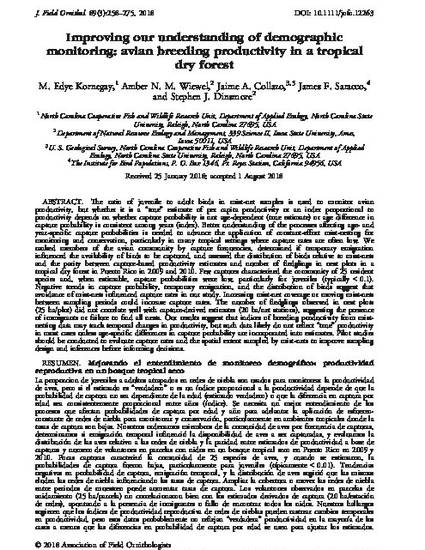
The ratio of juvenile to adult birds in mist‐net samples is used to monitor avian productivity, but whether it is a “true” estimate of per capita productivity or an index proportional to productivity depends on whether capture probability is not age‐dependent (true estimate) or age difference in capture probability is consistent among years (index). Better understanding of the processes affecting age‐ and year‐specific capture probabilities is needed to advance the application of constant‐effort mist‐netting for monitoring and conservation, particularly in many tropical settings where capture rates are often low. We ranked members of the avian community by capture frequencies, determined if temporary emigration influenced the availability of birds to be captured, and assessed the distribution of birds relative to mist‐nets and the parity between capture‐based productivity estimates and number of fledglings in nest plots in a tropical dry forest in Puerto Rico in 2009 and 2010. Few captures characterized the community of 25 resident species and, when estimable, capture probabilities were low, particularly for juveniles (typically < 0.1). Negative trends in capture probability, temporary emigration, and the distribution of birds suggest that avoidance of mist‐nets influenced capture rates in our study. Increasing mist‐net coverage or moving mist‐nets between sampling periods could increase capture rates. The number of fledglings observed in nest plots (25 ha/plot) did not correlate well with capture‐derived estimates (20 ha/net stations), suggesting the presence of immigrants or failure to find all nests. Our results suggest that indices of breeding productivity from mist‐netting data may track temporal changes in productivity, but such data likely do not reflect “true” productivity in most cases unless age‐specific differences in capture probability are incorporated into estimates. Pilot studies should be conducted to evaluate capture rates and the spatial extent sampled by mist‐nets to improve sampling design and inferences before informing decisions.
Available at: http://works.bepress.com/stephen_dinsmore/110/

This article is published as Kornegay, M. Edye, Amber NM Wiewel, Jaime A. Collazo, James F. Saracco, and Stephen J. Dinsmore. "Improving our understanding of demographic monitoring: avian breeding productivity in a tropical dry forest." Journal of Field Ornithology 89, no. 3 (2018): 258-275. doi: 10.1111/jofo.12263.